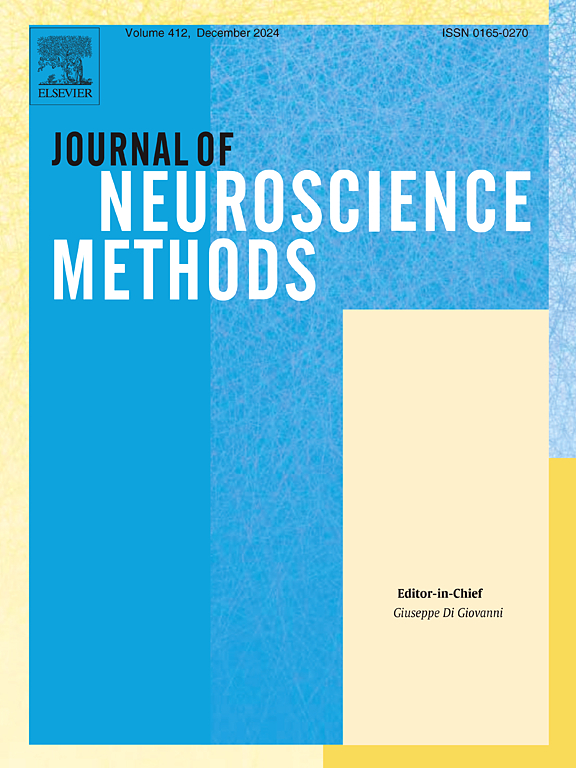Enhancing non-invasive pre-surgical evaluation through functional connectivity and graph theory in drug-resistant focal epilepsy
IF 2.7
4区 医学
Q2 BIOCHEMICAL RESEARCH METHODS
引用次数: 0
Abstract
Background
Epilepsy, characterized as a network disorder, involves widely distributed areas following seizure propagation from a limited onset zone. Accurate delineation of the epileptogenic zone (EZ) is crucial for successful surgery in drug-resistant focal epilepsy. While visual analysis of scalp electroencephalogram (EEG) primarily elucidates seizure spreading patterns, we employed brain connectivity techniques and graph theory principles during the pre-ictal to ictal transition to define the epileptogenic network.
Method
Cortical sources were reconstructed from 40-channel scalp EEG in five patients during pre-surgical evaluation for focal drug-resistant epilepsy. Temporal Granger connectivity was estimated ten seconds before seizure and at seizure onset. Results have been analyzed using some centrality indices taken from Graph theory (Outdegree, Hubness). A new lateralization index is proposed by taking into account the sum of the most relevant hubness values across left and right regions of interest.
Results
In three patients with positive surgical outcomes, analysis of the most relevant Hubness regions closely aligned with clinical hypotheses, demonstrating consistency in EZ lateralization and location. In one patient, the method provides unreliable results due to the abundant movement artifacts preceding the seizure. In a fifth patient with poor surgical outcome, the proposed method suggests a wider epileptic network compared with the clinically suspected EZ, providing intriguing new indications beyond those obtained with traditional electro-clinical analysis.
Conclusions
The proposed method could serve as an additional tool during pre-surgical non-invasive evaluation, complementing data obtained from EEG visual inspection. It represents a first step toward a more sophisticated analysis of seizure onset based on connectivity imbalances, electrical propagation, and graph theory principles.
通过功能连接性和图论加强耐药性局灶性癫痫的非侵入性术前评估
背景:癫痫是一种网络障碍性疾病,其发作从有限的起始区传播到广泛分布的区域。准确划分致痫区(EZ)对于耐药性局灶性癫痫的成功手术至关重要。头皮脑电图(EEG)的视觉分析主要阐明癫痫发作的扩散模式,而我们则利用脑连接技术和图论原理,在发作前到发作过渡期间界定致痫网络:方法:在对局灶性耐药性癫痫进行手术前评估时,我们从五名患者的 40 通道头皮脑电图中重建了皮层源。在癫痫发作前十秒和发作开始时估算了时间格兰杰连通性。使用图论中的一些中心性指数(Outdegree、Hubness)对结果进行了分析。考虑到左右相关区域最相关的枢纽度值之和,提出了一种新的侧向化指数:结果:在三名手术效果良好的患者中,对最相关枢纽区域的分析与临床假设密切吻合,证明了 EZ 侧化和位置的一致性。在一名患者中,由于癫痫发作前的大量运动伪影,该方法提供的结果并不可靠。在第五位手术效果不佳的患者中,与临床上怀疑的 EZ 相比,所提出的方法提示了一个更广泛的癫痫网络,提供了传统的电-临床分析所无法获得的令人感兴趣的新指示:结论:所提出的方法可作为手术前非侵入性评估的额外工具,补充脑电图视觉检查所获得的数据。它是基于连接失衡、电传播和图论原理对癫痫发作进行更复杂分析的第一步。
本文章由计算机程序翻译,如有差异,请以英文原文为准。
求助全文
约1分钟内获得全文
求助全文
来源期刊

Journal of Neuroscience Methods
医学-神经科学
CiteScore
7.10
自引率
3.30%
发文量
226
审稿时长
52 days
期刊介绍:
The Journal of Neuroscience Methods publishes papers that describe new methods that are specifically for neuroscience research conducted in invertebrates, vertebrates or in man. Major methodological improvements or important refinements of established neuroscience methods are also considered for publication. The Journal''s Scope includes all aspects of contemporary neuroscience research, including anatomical, behavioural, biochemical, cellular, computational, molecular, invasive and non-invasive imaging, optogenetic, and physiological research investigations.
 求助内容:
求助内容: 应助结果提醒方式:
应助结果提醒方式:


